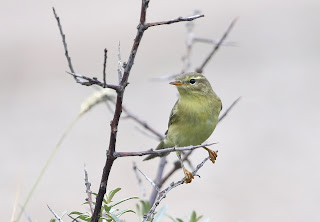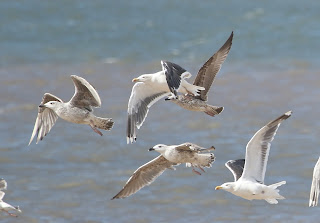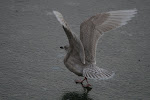After starting the week with a lot of surveys, I was allowed a day off. I should really have had a rest as I'm ridiculously tired, but the days leading up to this day off held record counts of Willow Warblers and also very good numbers of Pied Flycatcher at Spurn. In addition there were several Wryneck, Icterine Warblers and a nice Greenish Warbler...It was a no brainer.
After checking my moth trap early doors, I set off and arrived at Canal Scrape at about half 10 and met Liam, who was just about to see a juvenile Red-backed Shrike in Clubley's Field, which was the first bird I saw as I got out the car...not a bad start!
We had a quick brew ready to set off for the point and whilst we did, the bush outside the Warren common room held a male Redstart and 2 Pied Flycatcher.
Getting past the narrows, the first Willow Warblers were seen along with 2 Common Sandpiper. Around the Sheep Field, we saw our first Pied Flycatcher and migrants were certainly obvious with loads of Willow Warblers and a couple of Whitethroat. Just before the lighthouse, I spotted two brown birds flying into a bush, which on reflection were probably Dunnock, and curiosity got the better of me. We walked over and I flushed a brown/grey bird with a long tail and a rufous speckled back. As it was about to land, I was expecting a Shrike to appear in the bins, but it failed to land and started undulating and revealed a yellowy throat and a very skinny body. It just had to be a Wryneck! I managed to get a couple of perched views and was over the moon to finally see a Wryneck in the UK taking me to 362 species BOU.
Heading down to the end of the point, we picked up Spotted Flycatcher, Tree Pipit, 3 Wheatear and about 7 Whinchat. Pied Flycatcher numbers probably hit 40 with flocks of up to 6 and Willow Warblers must've hit 80 at least.
Moving back up, we sat next to the heligoland in the potato fields as there was a hive of activity in terms of willow warblers. We gave it a good 15 minutes and saw about 20 Willow Warblers.
A bird suddenly appeared in an Elder which Liam and I instinctively got onto as soon as we saw it. It was startlingly pale and looked almost silver with the naked eye. It was basically white underneath with a clean throat and pale face. It was an obvious supercillium that appeared to get broader behind the eye and a pale green upperbody. As it dipped down to fly, I am positive I noted a wing bar. It looked very good for Greenish, so we waited a good while for it to reappear but frustratingly, it never did. I have never seen Greenish, so I didn't know they could look that pale, otherwise I might've been quicker off the mark with the camera. Would've been a quality bird to end what was a fantastic trip to the point, but oh well....
On the walk back up from the point, we stopped at Chalk Bank to check any roosting gulls and waders. In amongst the Sanderling and Dunlin, there was a lovely juvenile Curlew Sandpiper and in amongst the gulls was a bird that initially gave us a little confusion. Liam's first thought was 1st summer LBBG due to the paleness of it compared to a standarly dark juvenile. I was instantly struck by the rather chunky bill, white basal colour long legs. I also noticed it had all juvenile scapulars (with the exception of possibly a couple of replaced feathers (was hard to see). It wasn't a 1st summer and I had my suspisions that it was a Yellow-legged Gull. As it took flight, there was a pale window to the inner primaries, fairly white rump and black tail band. It was indeed a fantastic juvenile Yellow-legged Gull. The first I've found in the UK of this age.
(Liam Langley)
(Liam Langley)
(Liam Langley)
After a quick cup of tea post-point, I headed back to Preston, stopping just north of Kilnsea Wetlands to scan a flock of gulls loafing in a newly cultivated field. There were 23 Med Gulls in there, which was a real shock considering there were only about 150 gulls and 30 Sandwich Terns.





















No comments:
Post a Comment